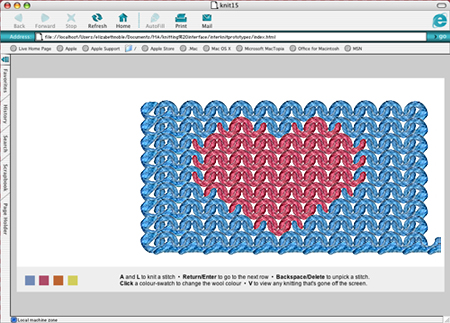 |
|
|
The knitting interface came from thinking about how we use the computer instead of other means. How our life has become virtual. How we organise our life through the keypad. And use the computer as a form of entertainment. My laptop was my filing system. I had started using stickies on my laptop instead of post its. I sent emails instead of letter. I surfed instead of going to library or making phonecalls. I banked and shopped so I could save time going into town. I tidied and organized my virtual desktop rather than my desk. I maintained my virtual home but not my real one. I had friends that would spend hours playing cards or pinball on their computer. I wanted to further explore why we choose to do things on the computer and experience how knitting on the Web would be different. "If computers are the power looms of the modern industrial revolution, software is more like knitting. Programmers still toil in digital sweatshops coding software by hand, writing and rewriting one tangled line after than another. Not surprisingly, they sometimes drop a stitch, which later unravels as a bug in the program." Zeros + Ones:digital women + new technoculture. London. Fourth Estate. p 127 I tried to mimic the actions of knitting as much as possible. Two keys on the keyboard that were horizontally opposite at each side of the keyboard were chosen to represent the right and left hand. By hitting one key after another one can create a row. By hitting return users can go onto the next line. One can change colour and has an option of changing the style of the stitch to a knit and purl. 12 separate sounds are attached to the keys to give the sound of knitting. One can undo by pressing delete/backspace. If the users revisit their knitting it will load where they last left off. Just like all those knitting projects I've started and never finished. They linger around. The project is ironic. Why would someone possibly knit online as opposed to the real practise. I aimed to create a feeling of discontentment through using the interface. Tactility is one of the most important aspects of knitting or working with any textiles, the interface removes this. By knitting online one get a experience similar to knitting but by no means a true representation. The act of knitting becomes easy. It looks neat, no stitches are dropped, no mistakes made. It's dull and lifeless, it's lacking in character and individualism. It looks just like the next persons knitting. Does this feed our imagination or dull it? Do we begin to think of the way we could personalize it., make it different. Similar to how we treat our desktops. Or do we just accept that it looks like everyone else. Is there comfort in knowing there are others like us? How much individualism and character can one have if represented by a machine.? Doesn't the tool dictate our options? The computer is a single unit designed for one user at a time. Therefore when working on a machine one works in isolation. When working on a computer one gets locked into the screen. We become disengaged with our environment. While knitting our minds can be free to engage with other things. The knitting interface removed this. Traditionally Knitting is an act that has brought people together. A friend and I had discussed knitting online via webcam. I had considered creating a chat forum that was a knitting circle or entering one as a knitter to see what reaction I would get. "Traditionally people came together to knit. It's about making objects, but it is also about sharing stories, an oral tradition. I really do believe this, " he says. "If more people knitted, the world would be a more peaceful place." The Guardian (Jan 31, 2005) Principal Protest Turns to the Radical Art of Knitting. Findings suggest that people get depressed when they are alone, and that they revive when they rejoin the company of others. Csikszentmihalyi, Mihaly. (1997 ) Finding flow - Creativity and optimum functioning. Harper Collins. Inter-Knit was programmed by Ian Truelove - www.iantruelove.com
|